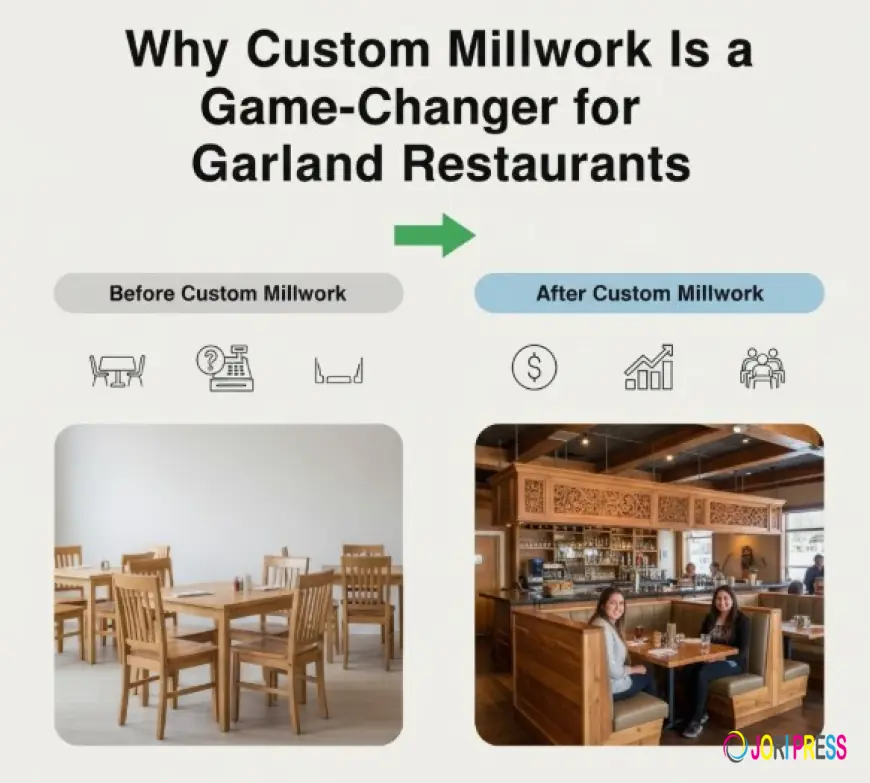Why Custom Millwork Is a Game-Changer for Garland Restaurants

Let’s be honest. In a city like Garland, with its rich history and a dining scene that’s exploding with flavor and personality, how do you make your restaurant stand out? You can have the most mouth-watering brisket in Texas, the most innovative fusion tacos, or the coziest coffee shop brew, but if your space doesn’t tell a story, you’re only fighting half the battle.
Think about the last time you walked into a restaurant and just went, "Wow." What was it? Was it just the smell of garlic and herbs? Probably not. It was the feeling. The warmth of the wood, the unique curve of the bar, the way the booths felt like a private cocoon. That, my friend, isn’t an accident. That’s the magic of custom millwork.
You see, off-the-shelf furniture and generic designs are like a canned sauce—they get the job done, but they lack soul, depth, and that secret ingredient that makes something truly memorable. Custom millwork, on the other hand, is a from-scratch, chef-driven masterpiece. It’s the art of designing and building wooden architectural elements—bars, tables, shelving, wall paneling, you name it—tailored specifically for your space and your vision. And for Garland restaurants, it’s not just a luxury; it’s a complete game-changer.
Beyond Four Walls and a Ceiling: Crafting an Unforgettable Atmosphere
Imagine you’re themed around Garland’s own railroad history. You could hang a few vintage photos, sure. But what if your entire hostess stand was crafted to resemble the front of a classic steam locomotive, with polished oak and brass fittings? What if your communal table was a single, breathtaking slab of reclaimed pecan, with the knots and grain telling a story of Texas itself? That’s the power of millwork. It transforms a theme from a suggestion into a tangible, immersive experience.
When a customer steps inside, they’re not just entering a building; they’re stepping into a narrative. RHQ Store specializes in custom millwork that builds that narrative from the ground up. It creates an atmosphere that a QR code menu and a Spotify playlist can only dream of. It’s the difference between a room that holds people and a room that holds people captive with its charm.
The Psychology of Space: Why We Feel What We Feel
Have you ever noticed how a low, intimate ceiling with warm, dark wood paneling makes you want to lean in and share a secret? Or how a bright, airy space with clean, light-toned ash trim makes you feel refreshed and alert? This isn’t by chance. We have deep, psychological responses to textures, colors, and the scale of our surroundings.
Custom millwork leverages this beautifully. A rustic, family-style Italian eatery can use distressed cherry wood for its wainscoting to evoke a sense of old-world, nonna’s-kitchen comfort. A modern cocktail bar can use sleek, vertically-grained walnut and sharp, geometric lines to feel sophisticated and exclusive. This control over the emotional dial of your dining room is priceless. You’re not just decorating; you’re engineering an emotional response that ensures your customers feel exactly how you want them to feel—relaxed, excited, romantic, or sophisticated.
The Garland Advantage: Local Flavor, Literally
Here’s where it gets really exciting for us here in Garland. Custom millwork allows you to weave the very fabric of our community into your restaurant’s DNA. You’re not just buying furniture; you’re investing in a local story.
Imagine this:
-
Sourcing Local Woods: Instead of using imported pine, what if your tabletops were made from East Texas post oak, the very wood used to smoke our famous Texas BBQ? The connection is instant and powerful.
-
Nodding to History: A millworker can incorporate design elements that reflect Garland’s heritage—perhaps a subtle pattern in the back-bar shelving inspired by the architecture of the downtown square, or a chair spindle design that echoes the work at the Landmark Museum.
-
Celebrating Craftsmanship: By hiring a local artisan or woodworking shop, you’re not only getting a unique product, you’re building a relationship. They understand the context. They’re your neighbors. They have a stake in making your restaurant a landmark because it’s their landmark, too.
This local connection becomes a powerful marketing tool. People love supporting businesses that support their community. It adds a layer of authenticity that a chain restaurant could never replicate.
A Practical Powerhouse: More Than Just a Pretty Face
Now, you might be thinking, "This all sounds beautiful, but is it practical for my bottom line?" The answer is a resounding yes. While the initial investment in custom millwork can be higher than buying catalog items, the long-term return on investment is where the real magic happens.
Durability That Pays for Itself
Mass-produced tables and chairs are built for mass markets. They’re often made from particleboard, veneers, and flimsy hardware that can’t withstand the daily war of a busy restaurant. A spilled drink can warp them, a heavy plate can dent them, and after a year, they look… tired.
Custom millwork, however, is built for battle. It’s constructed from solid hardwoods—oak, maple, walnut, hickory—joined with time-tested techniques like dovetails and mortise-and-tenon. This is furniture built to last for decades, not just a few seasons. You’re not constantly replacing chipped tables or wobbly chairs, which saves you money, hassle, and downtime in the long run.
Maximizing Every Single Inch
Garland restaurants come in all shapes and sizes, especially in our charming, sometimes quirky, older buildings. Have an awkward, narrow nook that standard tables won't fit? A weird column right in the middle of the floor? Custom millwork doesn’t see problems; it sees opportunities.
That nook becomes a cozy, coveted booth for two. That column becomes a stunning, functional centerpiece with wrap-around shelving for wine bottles or condiments. Custom work ensures that there is not a single square inch of your rent-paying space that goes to waste. It’s the ultimate optimization, turning architectural flaws into unique features that customers will remember and request.
The Competitive Edge: Standing Out in a Crowded Market
Let’s get down to brass tacks. The Garland food scene is competitive. To survive, you need a Unique Selling Proposition (USP). Your food is one, but your ambiance is another. In the age of Instagram and Yelp, your interior design is free marketing.
A stunning, custom-crafted live-edge bar is a backdrop waiting for a thousand social media posts. A beautiful, hand-made pergola over your patio doesn’t just provide shade; it provides the "vibe" that gets tagged online. People don’t just post pictures of their food anymore; they post pictures of themselves in beautiful spaces. Custom millwork makes your restaurant inherently "shareable," drawing in customers who are looking for that perfect photo and, more importantly, a memorable experience.
It signals quality. If a owner invests this much care and attention into the physical space, the customer instinctively believes the same care and attention goes into the food, the service, and the overall experience. It builds trust and justifies your price point before a single menu item is ordered.
The Proof Is in the Plywood: A Tale of Two Establishments
Let’s make this concrete with a little comparison. Let’s look at two hypothetical Garland restaurants.
The Standard Setup: "Generic Grill"
This place has good food. But the interior is a sea of booths from a restaurant supply catalog, laminate-top tables, and generic, mass-produced wall art. It’s functional. It’s clean. But it’s also the same as five other places within a ten-mile radius. There’s no "there" there. Customers come, eat, and leave. They’re loyal to the convenience or the price, but not to the soul of the place—because it doesn’t have one.
The Millwork Masterpiece: "The Artisan’s Table"
From the moment you walk in, you know you’re somewhere special. The hostess stand is a work of art, with inlaid wood representing the Trinity River. The bar is a massive, hand-planed slab of mesquite, its surface glowing under the lights. The banquettes are upholstered in rich, durable fabric and are built into alcoves framed with custom fluted wood panels, offering both privacy and beauty. The entire space feels cohesive, intentional, and deeply connected to its Garland roots. Customers linger over another drink. They take photos. They become regulars, not just customers, because they feel a part of something special.
The Tangible Benefits Breakdown
| The Standard Setup | The Millwork Masterpiece | |
|---|---|---|
| Atmosphere | Familiar, functional, forgettable. | Unique, immersive, memorable. |
| Durability | Prone to wear and tear; needs frequent replacement. | Built to last for decades; a long-term asset. |
| Space Utilization | Must fit the space to the furniture, often wasting awkward areas. | Furniture is built for the space, maximizing every inch. |
| Brand Identity | Weak; blends in with competitors. | Strong and unmistakable; tells a unique story. |
| Customer Perception | Sees it as a place to eat. | Sees it as a destination and an experience. |
| Marketing Value | Relies almost entirely on food and ads. | The space itself is a shareable, powerful marketing tool. |
| Local Connection | None. | Deep; can incorporate local materials and themes. |
Making the Investment: How to Get Started
Feeling inspired? The process of incorporating custom millwork is a collaborative journey. It starts with a vision. Talk to a local millworker or a designer who specializes in commercial spaces. Bring them your ideas, your theme, even a piece of fabric or a photo that captures the mood you want. They can translate that into a functional, breathtaking reality.
Think of it as hiring a chef for your space. You give them the ingredients of your dream—your concept, your brand, your story—and they create a masterpiece that your customers can literally sit inside.
The Final Course: More Than Just Wood
So, why is custom millwork a game-changer for Garland restaurants? It’s simple, really. In a world of mass production and fleeting trends, it offers authenticity, durability, and soul. It transforms your restaurant from a mere food-service location into a landmark. It creates an emotional anchor that keeps customers coming back and gives you an unshakeable identity in a crowded and competitive market.
What's Your Reaction?
 Like
0
Like
0
 Dislike
0
Dislike
0
 Love
0
Love
0
 Funny
0
Funny
0
 Angry
0
Angry
0
 Sad
0
Sad
0
 Wow
0
Wow
0







![Introduction ?98~[(2121)]?~[{0875}] to the stock market course](https://joripress.com/uploads/images/202509/image_430x256_68bfbfdebfba4.webp)









































